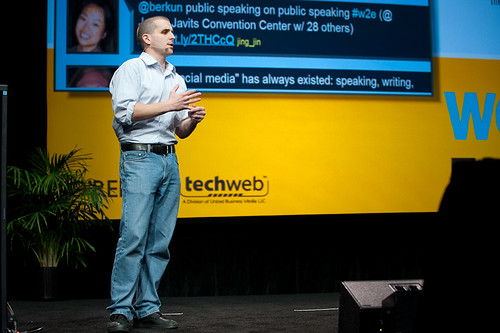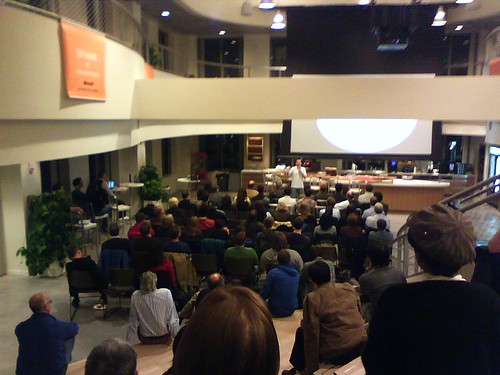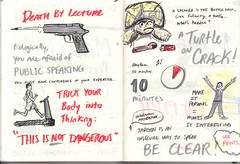Last week I gave a keynote at Web 2.0 expo NYC, and as you can see in the photo below, one of the interesting things this year was the twitter feed for the conference was placed on stage behind the keynote speakers. Any tweet with #w2e was put up live, on stage, a few seconds later. The slides, if any, speakers used were placed on the large screens to the left and right of the stage. I’ve seen twitter on stage, and presented with it up before, but never right behind me on stage.

The cognitive science here is simple: anything in motion on stage takes attention away from anything else. Even if I were JFK or MLK, if you put a moving screen behind me, with blocks of twitterness appearing randomly every 20 or 50 seconds, it can’t possibly help anyone understand anything. It divides attention away from whatever it is the speaker is trying to do. Unlike pop-up videos on VH1, this isn’t an 80s video you’ve seen 100 times that needs spicing up, at any time, by anyone with a twitter account, in the room or perhaps even not.
An hour lecture is one thing, but for short 10 or 15 minute keynote sessions in front of an audience of 2000+ people, which is what these were, the cognitive science is working against doing anything that the speaker isn’t orchestrating him or herself.
For danah boyd, who spoke a day earlier, the mirror in mirror effects of allowing the audience to have control over the stage worked against everyone involved, including the audience . It hurt danah’s ability to do what people came to hear her do, and gave a minority of the audience a minor round of momentary, but ultimately forgettable snarkishness instead. (Read her thoughtful post about what happened here and/or read the actual twitter feed).
Now I’m all for snarks. In fact I’m all for people speaking up when I’m not doing my job as a speaker. It is a kind of feedback, and if I can hear the complaint there’s a chance I can do something with it. But If I can’t even hear you, who exactly are you complaining to? There’s a 0% chance I’ll get the message if I can’t see or hear it when it’s delivered.
Speaking in public is hard enough. And while I’m all for people having their say, and getting involved, putting words up on a screen behind me is not an effective way to do it. At a minimum, put the twitter feed up somewhere I can see it, on a side screen, so there’s a 10% chance I’ll figure out why everyone is laughing when I don’t think they should be. At least a speaker might have a fighting chance. Or enlist the host to watch, and let them tell me if I’m going to fast, or too slow, or doing something easy to fix.
To Brady and Jen’s credit (Web 2.0 co-chairs), they did make an announcement the next day and take responsibility for what happened, switching the feed to moderated. Speaking up at the event itself was brave and cool of them to do. They, in essence, took the back-channel chatter about the back-channel issues, and brought it up to the frontchanel. Postmoderm indeed.
If you’re thinking of using visible twitter feeds as part of your event consider this:
- What problem are you trying to solve? If you want more interactivity, you must either make the sessions longer, smaller, or have a Phil Donahue type person who can field questions from twitter, or the audience, in real time and pass them on to the speaker. If your audience gets bored, get better speakers. Or train them. Or perhaps buy them all a good book on the subject from an author who writes about this stuff).
- Help speakers, don’t work against them. At nearly every event, the speakers are the agenda. We are your primary draw. Even if we suck, people come because you listed us as the reason to come. In the green room backstage at Web 2.0, I asked nearly every other keynote speaker if they thought the stream behind our heads was a good idea. Not a single one said yes (of course they’d all seen danah’s experience, so we benefited from her rough ride). If we’re the agenda, work with us, not against us. If you want us to speak better, or be more interactive, then ask us or train us in the arts of public speaking.
- Break sessions in half and interact some dialog in the middle. Matt Mullenweg cleverly divided his 60 minute session at web 2.0 in half, taking a break for questions in the middle. Why not do the same for 20 minute keynotes? at the ten minute mark, have the host pull one question from twitter, email, or smoke-signals, and ask the speaker. If everyone knows this is part of the routine, there will be less pressure on the back channel – they know there is a path for their comments or questions to hit the front channel. This can be tight for 10 minute keynotes, but it’s preferable to giving back-channel control the entire time.
- Some people like the back-channel staying in the back-channel. If I’m joking around, as if I was passing notes in high school, I don’t want my snide comments broadcast. I’m sure some folks at #w2e made a new tag, #web2realbackchannel to get around this, or more likely, simply didn’t use twitter at all, since they didn’t want their words, and twitter handle broadcast to the room.
- Interaction doesn’t have to be real time. The real thing people want is a chance to interact with the keynote folks. So why not have a designated time when they’re all around in the same place, say at lunch? Or have an email address anyone with a question for a keynote speaker can send, anonymously, and post the answers to the event blog? All of these solve the core problem, of being interactive and participatory, without any of the drawbacks of competing for attention simultaneously with the speaker.
Despite what happened, I’m a big fan of experimenting with public speaking, and finding ways to make it a better experience for everyone involved. Brady & Jen get some points for trying something new, and making adjustments when it caused problems. But changes can be driven by what we know about cognitive science, attention, and be a collaboration between speakers and organizers. I’m very hopeful dialog around all this will spin in that direction, instead of simply giving up and banning things without examining what can go wrong and why, or what the real problems are we’re trying to solve by having speakers up there in the first place.
(You can watch my web 2.0 expo keynote here)





